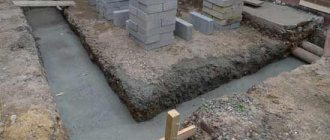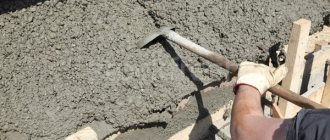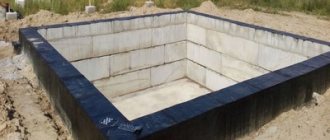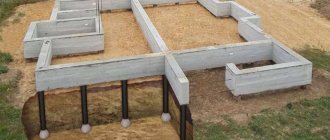Beton-House.com
Website about concrete: construction, characteristics, design. We combine the experience of professionals and private craftsmen in one place
Concreting in rainy weather
The strength of the structure under construction and its reliability are directly related to the quality and composition of the concrete intended for pouring the foundation. The characteristics of the external environment are also taken into account; the weather almost always adjusts the work process.
Is it possible to pour concrete in the rain, will the maximum quality be achieved? It is definitely impossible to answer this question. Water is one of the components of concrete and does not cause significant harm to structures made from. When there is excess water, numerous air bubbles form inside the mixture and, as a result, the load-bearing capacity weakens.
Is it possible to pour concrete in the rain? In some cases it is even necessary
Experts note that pouring concrete in rain or wet weather is possible without the risk of losing the reliability of the structure, because concrete is a universal material and can sometimes be poured under water. It is necessary to carefully monitor the amount of water during work and avoid excess. Some techniques that we note below will help when working in the rain.
Weather conditions for high-quality concreting
It is necessary to realize that the durability of the structure directly depends on the experience and qualifications of the craftsman who carries out the concreting. One of the main factors affecting service life is meteorological conditions during concrete pouring.
According to technology, the foundation should be poured in dry, warm and stable weather. And many experts in the field of construction insist on this opinion. But it is not so.
Delving into the physics of this process, it is important to note that the primary connecting link of the concrete mixture, cement, hardens when combined with water, but at an air temperature of about 20 ° C.
The photo shows a monolithic foundation poured in summer weather
The most optimal time of year with favorable wet conditions for pouring concrete is autumn. But in autumn there is a risk of frost. In this case, the temperature regime during concrete hardening is disrupted.Important! Cement is a hydraulic binder and gains strength faster at 80% air humidity. Therefore, it is even recommended to pour concrete in light rain or humid, cool weather; the concrete will set and harden better. This will certainly affect the strength of the structure under construction.
Due to the temperature difference, stresses arise in the unhardened body itself, which subsequently cause cracks. To avoid this situation, you can use antifreeze additives.
They give the necessary strength to concrete. It would also be a good idea to “wrap” the freshly poured formwork with construction felt and film.
Causes of foundation destruction
No matter how strange it may sound, developers independently determine the operational life of the installed foundation. Most often, the foundation is the foundation laid under the structure, which has several layers. Each layer is made from building materials that are not always similar in properties to each other. Under the influence of precipitation, they behave completely differently. An important condition for a high-quality and correctly laid foundation of any type is strict adherence to technology. Paying attention to weather conditions, in this case, is also equally important.
Rain for a slab-type foundation when digging a pit or a strip foundation when constructing a trench is not so terrible. The main thing is to be careful to ensure that prolonged precipitation does not make the soil too wet. Here you should pay attention to whether there is clay in the soil. If its presence is minimal, then nothing threatens the construction of the foundation.
Many people believe that it is worth building a foundation only in dry weather. However, this is not quite true. The cement composition hardens only when interacting with water, and the temperature should be from 18 to 20 degrees Celsius. In addition, cement becomes more durable at 80 humidity.
However, if we consider this issue from the other side, it is the excessive saturation of the concrete mixture with water that makes the constructed foundation less strong and destroys it.
Here are some facts:
- Water washes away the solution, which contributes to the exposure of the reinforcing mesh.
- When the temperature drops, the water mass may freeze, and this will also negatively affect the integrity and strength characteristics.
Carefully! Experts EXTREMELY do not recommend starting or continuing the construction of a foundation even with minimal threat of concrete freezing! The most optimal time for such work is autumn. But here you also need to be careful and careful. There is always a risk of early frosts.
How can rainy weather affect the quality of the resulting concrete?
If concrete is oversaturated with liquid, it may collapse after setting. This can happen when the mixture is washed out, exposing the reinforcement mesh.
Or if water does not have time to react with cement before sub-zero ambient temperatures appear, it will freeze, and the concrete becomes loose and permeated with a network of microscopic ice floes. This phenomenon will negatively affect the strength of concrete.
What causes excess water in a concrete mixture?
It is highly not recommended to do concreting if there is a threat of water freezing. It is worth stopping the work so as not to redo it in the future. Rain can ruin the concrete surface, but if at the same time (already in a compacted concrete mixture) the adhesion processes of the concrete composition are not completed.
Cooking technology
Preparing the mixture is an important step in the process. It is necessary to take into account all the nuances of mixing the solution when working in the rain. Step-by-step technology will help you understand the features:
- at the beginning of work, prepare a covered canopy so that water does not get into the containers with the solution;
- First, one part of cement, grade no lower than 400, is poured into the solution container;
- then add 1.9-2 parts of river sand and mix the components dry;
- then add water to combine the components. Water in the mass makes up 0.5 parts of the binder. During rain, the amount of water can be reduced;
- 3.9 parts of gravel are added to the almost finished solution.
After combining all the components, the contents are thoroughly mixed for several minutes. It is these proportions that make it possible to obtain concrete that can withstand loads and have high strength.
Recommendations for concrete work in rain
When working with concrete at high humidity, it is recommended to follow some tips:
- Use high-quality cement for work . M400 and M500 will make it possible to produce concrete with high moisture resistance; such a solution hardens faster, but their use is not entirely profitable due to the high price.
- Use plasticizers . This is a special material based on polymers. They allow you to regulate fluidity, thereby avoiding voids, reducing pore sizes, and increasing durability. Certain components increase the adhesion of such mixtures to metal reinforcement and within the concrete itself. Plasticizers make concrete stronger, waterproof and durable, although their price is considerable.
- To eliminate voids inside, use vibration equipment to create an artificial compaction of the solution , which allows the mixture to adhere better and more reliably to the reinforcement.
- To protect from downpours, light canopies are sometimes installed on metal or wood posts, and concrete mixture and formwork are covered under a film. If the weather is sunny, then the canopy can be removed. But, it is left for some time after the work is completed, when it may rain after pouring the concrete. Given the large area for work, it will be necessary to attract additional financial resources.
Pouring concrete in the rain is an excellent reason to build an impromptu canopy
All water is removed and only after concrete is poured
Is it possible to pour concrete into water if the foundation pit is filled with water? There is definitely no need to carry out concrete work, because there is a risk of forming a poor-quality foundation, which could subsequently destroy the entire house.
In this case, you can drain the trench with a drainage pump, then, after assessing the possibilities of moving special equipment and workers through the wet ground, pour concrete. It is also possible to wait time (if there is enough time) and the water will go away on its own, of course taking into account the meteorological forecast. The choice of solution to such a problem in construction is individual.
What you need for concrete work in rainy weather
What you can’t do without when concreting
With different financial capabilities and different methods of filling with your own hands, they work with a wide variety of equipment.
Here is a rough list:
- When mixing the solution, you will need a container, bucket, shovel, mixer or concrete mixer, which will improve the quality of the concrete.
- A film made of polyethylene to cover the finished solution and the already poured structure.
- To obtain denser concrete, an electromechanical vibrator is used, with a certain amount of vibration transmitted to the solution, represented by a motor, eccentric, and transmission mechanism. This increases strength and removes excess moisture.
- When feeding at low heights, a supply channel can be used.
For large-scale pouring, the use of a concrete pump is recommended.
Features of the work
A short instruction focusing on concreting in the rain:
- If necessary, dry the formwork, as mentioned earlier.
- If constant rain is expected, a canopy is organized using available materials. It can be made from boards and covered with film. Old pieces of slate and plywood can also come in handy. Don't forget to wrap the flooded area with film.
- After 2-3 days, making sure that the solution has set and hardened, it is necessary to remove the polyethylene, make vents in the base, and drill holes in the concrete with a diamond-coated tool in order to prevent the appearance of mold fungi. To carry out communications, small segments are separated from the base by cutting with diamond wheels.
Basic Concepts
How strong the foundation will be depends on the work being performed. The foundation is a multi-layer structure; a clear order of laying the layers is important. Preparatory work is easy to carry out in slushy weather. It is important to ensure that the soil is not oversaturated with water. Sand and crushed stone are good conductors of water, clay retains moisture. With minimal clay content in the soil, rain is not a hindrance.
It is known from physics that the interaction of cement with water improves its hardening; at high humidity (80%), the solution gains strength characteristics. The optimal air temperature is 18-20 degrees above 0.
Protect the mixture from rain using film.
You can pour concrete in rain or wet weather without risking losing the reliability of the structure. During the work, you just need to pay attention to the amount of water, do not allow excessive amounts. A number of techniques will help you work with concrete in the rain:
- use waterproofing material (film) to protect the mixture from water. Under the film there should be formwork and a container with mortar;
- use high grade cement in your work;
- use vibration equipment in your work to help avoid internal voids.
Return to contents
Pouring process
The filling procedure is divided into the following stages:
- Laying waterproofing material in a prepared frame prevents the penetration of moisture from below.
- Installation of reinforcing mesh inside the structure at a distance of at least 5 cm from the edge. The mesh parts are fastened together with wire.
- The formwork is covered with film cut into strips. The thickness of the strips can be different, depending on the width of the foundation, plus a margin. Cover the area where no work is being done with film.
- The solution is laid in parts - one section of the structure is freed from the film and the solution is poured inside, and so on until it is completely filled.
After a period of time, the solution will set and rain will not cause damage to the concrete; after drying, the film can be removed.
Additional operations
To prevent the formation of mold under the floor, it is necessary to make additional ventilation ducts. If they were not laid at the time of pouring the foundation, we do it after it dries. Holes can be made with diamond drilling. When organizing communications, part of the foundation will need to be cut out. Used for cutting with diamond wheels.
The strength of the structure under construction and its reliability are directly related to the quality and composition of the concrete intended for pouring the foundation. The characteristics of the external environment are also taken into account; the weather almost always adjusts the work process.
Is it possible to pour concrete in the rain, will the maximum quality be achieved? It is definitely impossible to answer this question. Water is one of the components of concrete and does not cause significant harm to structures made from. When there is excess water, numerous air bubbles form inside the mixture and, as a result, the load-bearing capacity weakens.
Experts note that pouring concrete in rain or wet weather is possible without the risk of losing the reliability of the structure, because concrete is a universal material and can sometimes be poured under water. It is necessary to carefully monitor the amount of water during work and avoid excess. Some techniques that we note below will help when working in the rain.











